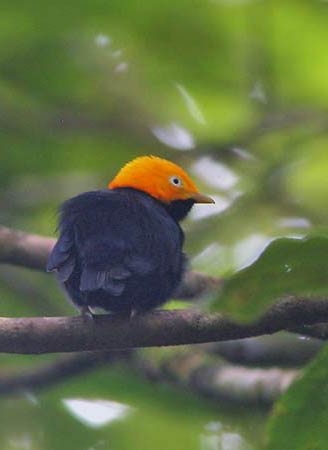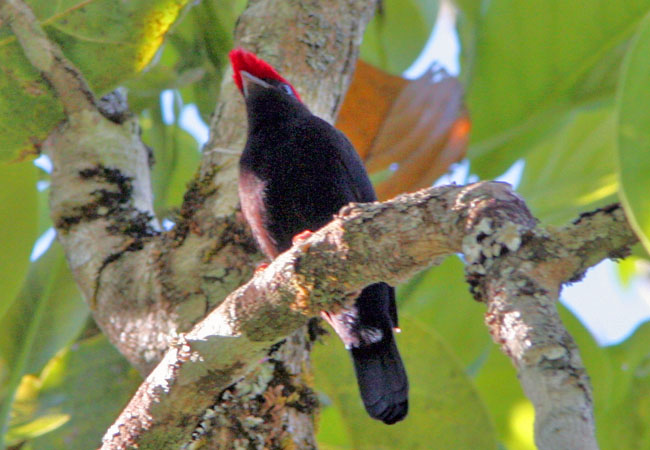
a web page by Don Roberson |
MANAKINS Pipridae |
|||
|
|||
Males display, but the cryptic females chose the male with which they mate, then thet build nests, lay eggs, and raise the young alone. The understory displays are similar in male White-collared Manakin (below), a species of northeastern South America and Trinidad. Snow (1962) studied a lek in Trinidad, at Asa Wright Nature Reserve, in detail, and that lek is still there today (it was where this photo was taken). |
|||
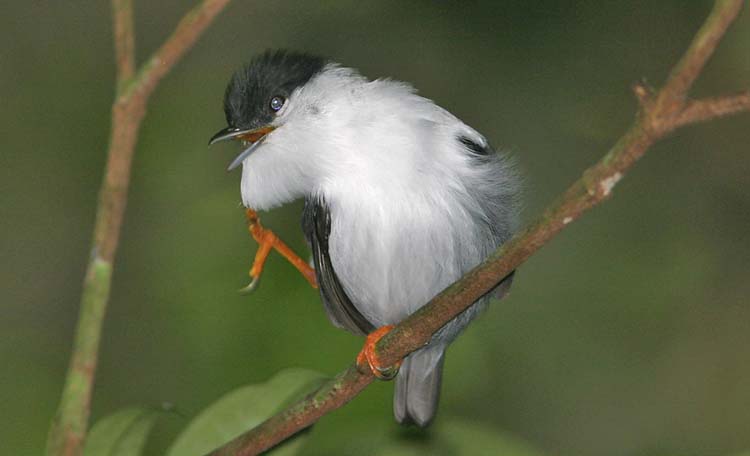 |
|||
While most manakins are birds of the forest understory, a few are canopy dwellers. One of these is Red-capped Manakin (right). It performs dances up higher in the sub-canopy, looking almost tailless (but there are species with long tails). According to Sick (1993), the manakins — like cotingids — evolved together with various types of tropical forest. Relying primarily on berries which were abundant year-round, these birds were free to evolve elaborate courtship displays by outlandishly customed males; plainly-patterned females come to lek sites to mate with the most prominent dancing male. Incredible footage of one manakin lek – in which only the alta male mates with the attracted females despite a dance display by several as a group – is in the Life of Birds video by David Attenborough. A scientific perspective on this type of display is in Prum (1990). Among all the species in which perform display and wear vivid colors, females are very drab in plumage and often to difficult to distinguish between species. Three examples of female manakins of this type are shown below. |
|||
|
|||
A little bit larger is Serra do Mar Tyrant-Manakin (left), an endemic of remnant Atlantic rainforest in coastal Brazil. Until very recently it was lumped with Wied’s Tyrant-Manakin Neopelma aurifrons, which largely replaces Serra do Mar Tyrant-Manakin to the north and at lower elevations in the Atlantic forest. We found it in a gulley with bamboo and ferns, where we were waiting for a calling antpitta to appear. Note the semi-concealed yellow coronal patch, apparently shown by both sexes. Yet it is the plumage, vocalizations, and lekking behavior of the gaudy understory manakins that causes the greatest wonder. While walking quieting in the forest, one listens for the repetitive calls of the males or for the rapid whirr of their wingbeats as they buzz from one display branch to another. In any visit to the Neotropical lowlands, seeking out the local manakins is one of the prime pleasures of the trip. Shown below is a male Golden-headed Manakin (below left), a lowland forest species from Panama to the Amazon River (and in Trinidad, where the photo was taken), and a male Helmeted Manakin (below right), with its red crest bending forward like an old Roman helmet. |
|||
|
|||
In a visit to central Brazil in August 1999, we encountered several very impressive manakins, including Helmeted (photo above on a later trip); the well-named Snowy-capped Pipra nattereri; and, best of all, the Fiery-capped Manakin Machaeropterus pyrocephalus. The latter was a lek near a salt-lick in the forest near Rio Cristalino Lodge in the very middle of the Brazilian Amazon Basin. The tiny active males, no bigger than a thumb, were candy-striped in red on white below with an orange top of the head and a red crest. Wow. Some day I must seek out the recently-discovered Araripe Manakin Antilophia bokermanni, restricted to a tiny patch of evergreen forest in northeastern Brazil. It was found in 1996 and described in 1998. With its forward-dipping red crest it recalls Helmeted Manakin — it is, in fact, the only other member of genus Antilophia —but the rest of the body plumage is white, contrasting with black wings and tail. It is listed as critically endangered, with a population estimate of just 800 birds, and declining. Some excellent photos appear in Hirschfeld (2007). One plain bird which used to be listed with the Pipridae was once called "Broad-billed Manakin," but today it is Sapayoa Sapayoa aenigma. Molecular studies have shown it is not a manakin but instead a remnant example of an Old World assemblage near the Broadbills [see Sapayoa family page]. Recent evidence suggests that the three species of piprites [genus Piprites] are also not manakins but are best placed within a comparatively new family, the Tityridae. The enigmatic Schiffornis assemblage, which had once been included in the manakins (e.g., Ridgely & Tudor 1994), are also part of the new Tityras family. These have been handled in various ways in the recent past (e.g., Sibley & Ahlquist 1990, Lanyon 1985, Prum & Lanyon 1989), but it now appears that the best course is to place them in the newly minted family; Ericson et al. (2006). |
|||
Photos: The male Orange-collared Manakin Manacus vitellinus was at Rio Tigre, Osa Peninsula, Costa Rica, on 26 Dec 2007. The male White-collared Manakin Manacus manacus was at Asa Wright Nature Reserve, Trinidad, on 25 Dec 2006. The male Red-capped Manakin Pipra mentalis was along the Chiva-Chiva trail, Canal Zone, Panama, on 12 Jan 1981; the female Red-capped Manakin was at Rio Tigre, Costa Rica, on 26 Dec 2007. The female and the male Golden-headed Manakin Pipra erythrocephala were at Asa Wright, Trinidad, on 26 Dec 2006. The female Pin-tailed Manakin Pipra militaris was in Intervales NP, Brazil, on 1 Aug 2010 [the male is drop-dead gorgeous but avoided the camera]. The Serra do Mar Tyrant-Manakin Neopelma chrysolophum was at Itatiaia NP, on 5 Aug 2010. The male Helmeted Manakin Antilophia galeata was in Emas NP, Brazil, on 27 July 2010.
Bibliographic note: There is no "family book" but the account by Snow (2004) in the Handbook of the Birds of the World series serves that purpose admirably. The collection of photographs there is astounding. However, it includes Sapayoa and birds in the Schiffornis assemblage which are now assigned to other families. Literature cited:
|
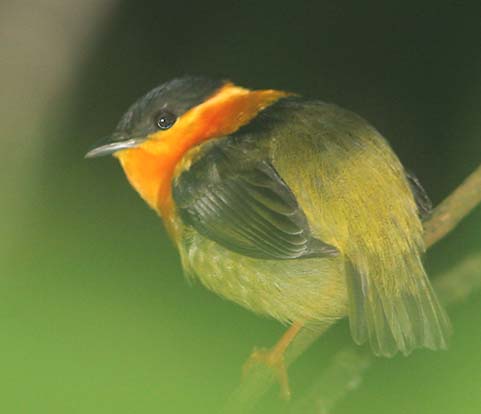 Manakins are tiny gems of the New World tropics. In many species the males are particularly attractive for their bright colors and lekking displays. They are very small birds of the forest interior, hard to see and even harder to photograph. A flash was used to capture most of the birds on this page. Orange-collared Manakin (left) displays on leks near the ground in humid lowlands from the Osa Peninsula, Costa Rica, to western Colombia. Up to two dozen striking males flit over the cleared "court" with its vertical saplings, audibly clicking their wings as they jump back and forth.
Manakins are tiny gems of the New World tropics. In many species the males are particularly attractive for their bright colors and lekking displays. They are very small birds of the forest interior, hard to see and even harder to photograph. A flash was used to capture most of the birds on this page. Orange-collared Manakin (left) displays on leks near the ground in humid lowlands from the Osa Peninsula, Costa Rica, to western Colombia. Up to two dozen striking males flit over the cleared "court" with its vertical saplings, audibly clicking their wings as they jump back and forth.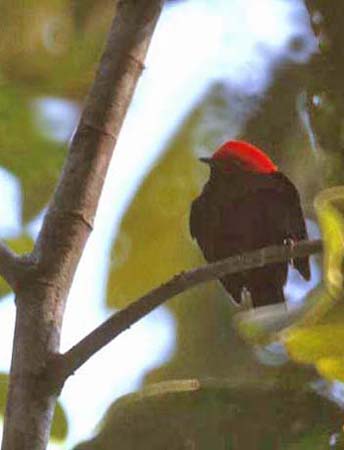
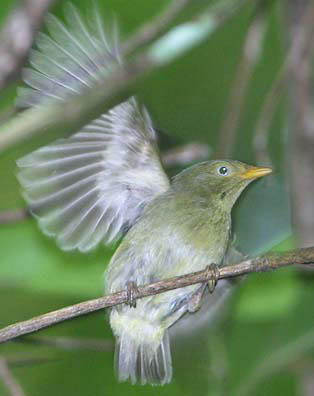
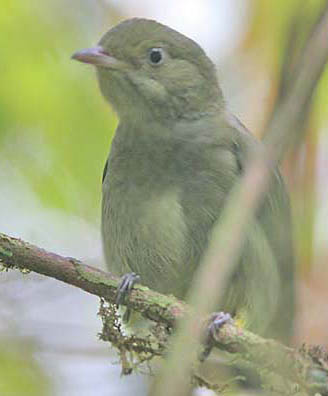
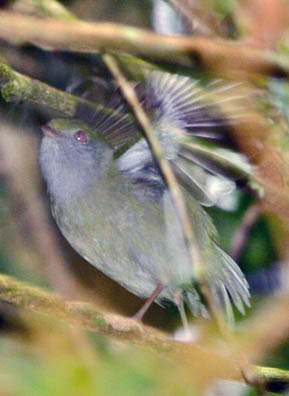
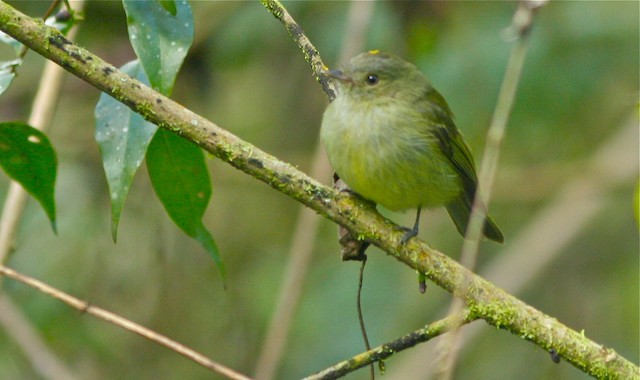 Although most of the male manakins shown on this page are strikingly attired, not all members of the family share this character. Some species are quite plain and in some there is no sexual dimorphism, with both sexes an unmarked and rather plan green: Olive Manakin Xenopipo uniformis, Green Manakin Cryptopipo holochlora, and the tyrant-manakins (7 species in genera Tyranneutes and Neopelma). The Tiny Tyrant-Manakin Tyranneutes virescens is, at 6-7 grams, one of the smallest birds on earth — only some hummingbirds are smaller.
Although most of the male manakins shown on this page are strikingly attired, not all members of the family share this character. Some species are quite plain and in some there is no sexual dimorphism, with both sexes an unmarked and rather plan green: Olive Manakin Xenopipo uniformis, Green Manakin Cryptopipo holochlora, and the tyrant-manakins (7 species in genera Tyranneutes and Neopelma). The Tiny Tyrant-Manakin Tyranneutes virescens is, at 6-7 grams, one of the smallest birds on earth — only some hummingbirds are smaller. 